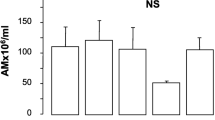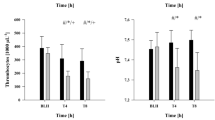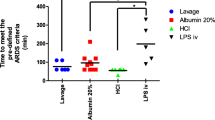Summary
To establish a stable and reliable model of refractory hypoxemia acute respiratory distress syndrome (ARDS) and examine its pathological mechanisms, a total of 144 healthy male Wistar rats were randomized into 4 groups: group I (saline control group), group II (LPS intravenous “single-hit” group), group III (LPS intratracheal “single-hit” group) and Group IV (LPS “two-hit” group). Rats were intravenously injected or intratracheally instilled with a large dose of LPS (10 mg/kg in 0.5 mL) to simulate a single attack of ARDS, or intraperitoneally injected with a small dose of LPS (1 mg/kg) followed by tracheal instillation with median dose of LPS (5 mg/kg) to establish a “two-hit” model. Rats in each group were monitored by arterial blood gas analysis and visual inspection for three consecutive days. Arterial blood gas values, lung wet/dry weight ratio and pathological pulmonary changes were analyzed to determine the effects of each ALI/ARDS model. Concentrations of TNF-α, IL-1 and IL-10 in the bronchoalveolar lavage fluid (BALF) and blood plasma were measured by using enzyme-linked immunosorbent assays (ELISA). Our resulsts showed that single LPS-stimulation, whether through intravenous injection or tracheal instillation, could only induce ALI and temporary hypoxemia in rats. A two-hit LPS stimulation induces prolonged hypoxemia and specific pulmonary injury in rats, and is therefore a more ideal approximation of ARDS in the animal model. The pathogenesis of LPS two-hit-induced ARDS is associated with an uncontrolled systemic inflammatory response and inflammatory injury. It is concluded that the rat ARDS model produced by our LPS two-hit method is more stable and reliable than previous models, and closer to the diagnostic criteria of ARDS, and better mimics the pathological process of ARDS.
Similar content being viewed by others
References
Li XF, Wang JX. The study progresses of acute lung damage animal model. Foreign Med Sci [Respir Syst] (Chinese), 2005, 7(1):25–27
Fang SD, Yang XX. Acute lung injury animal model establishment. Shanxi Med Coll J (Chinese), 2002, 33(3): 280–282
Xie YM, Chen HQ, Chen H, et al. Establishment of rat acute respiratory distress syndrome. China Exp Anim J (Chinese), 2002, 10(4):244–246
Bastarache JA, Blackwell TS. Development of animal models for the acute respiratory distress syndrome. Dis Model Mech, 2009, 2(5–6):218–223
Matute-Bello G, Frevert CW, Martin TR. Animal models of acute lung injury. Am J Physiol Lung Cell Mol Physiol, 2008, 295(3):379–399
Wang HM, Bodenstein M, Markstaller K. Overview of the pathology of three widely used animal models of acute lung injury. Eur Surg Res, 2008;40(4):305–316
Yeh CC, Kao SJ, Lin CC, et al. The immunomodulation of endotoxin-induced acute lung injury by hesperidin in vivo and in vitro. Life Sci, 2007, 80(20):1821–1831
Helden HP, Kuijpers WC, Steenvoorden D. Intratracheal aerosolization of endotoxin (LPS) in the rat: a comprehensive animal model to study adult (acute) respiratory distress syndrome. Exp Lung Res, 1997, 23(4): 297–316
Ware LB, Matthay MA. Alveolar fluid clearance is impaired in the majority of patients with acute lung and the acute respiratory distress syndrome. Am J Respiratory Crit Care Med, 2001, 163(6):1376–1383
Xie LX, Liu YN. Lung exogenetic and intergenetic ARDS. Chin J Intern Med (Chinese), 2003, 42(7):517–519
Rocker GM. Acute respiratory distress syndrome: different syndromes, different therapies? Crit Care Med, 2001, 29(1):210–212
Ranieri VM. Brienza N, Santostasi S, et al. Impairment of lung and chest wall mechanics in patients with acute respiratory distress syndrome: role of abdominal distension. Am J Respir Crit Care Med, 1997, 156(4): 1082–1091
Miehael AM, Guv AZ, Charles E, et al. Future research directions in acute lung injury: summary of a National Heart, Lung, and Blood Institute Working Group. Am J Respir Crit Care Med, 2003, 167(7):1027–1035
Rosenthal C, Caronia C, Quinn C, et al. A comparison among animal models of acute lung injury. Crit Care Med, 1998, 26(5):912–916
Hafner D, Beume R, Kilian U, et al. Dose-response comparisons of five lung surfactant factor (LSF) preparations in an animal model of adult respiratory distress syndrome. Br J Pharmaol, 1995, 115(3):451–458
Pelosi P, Cadringher P, Bottino N, et al. Sigh in acute respiratory distress syndrome. Am J Respir Crit Care Med, 1999, 159(3):872–880
Li Q, Qian GS, Zhang Q, et al. Study of acute lung injury induced by different doses of lipopolysaccharide in rats. Acta Acad Med Mil Tertiae (Chinese), 2001, 23(1): 1264–1266
Li HX, Zhang JC, Liu Y. The difference in acute lung injury caused by intratracheal instillation or intraperitoneal injection of LPS. Acad J PLA Postgrad Med Sch (Chinese), 2003, 24(1), 5–7
Sato K, Kadiiska MB, Ghio AJ, et al. In vivo lipid-derived free radical formation by NADPH oxidase in acute lung injury induced by lipopolysaccharide: a model for ARDS. FASEB J, 2002, 16(13):1713–1720
Van Helden HP, Kuijpers WC, Steenvoorden D, et al. Intratracheal aerosolization of endotoxin (LPS) in the rat: a comprehensive animal model to study adult (acute) respiratory distress syndrome. Exp Lung Res, 1997, 23(4): 297–316.
Di Filippo A, Rinaldi S, Pascente C, et al. Blunted inflammatory response to lipopolysaccharide endotracheal instillation due to thermal preconditioning. Minerva Anestesiol, 2005, 71(10):601–607
Domenighetti G, Stricker H, Waldispuehl B. Nebulized prostacyclin (PGI2) in acute respiratory distress syndrome: impact of primary (pulmonary injury) and secondary (extra-pulmonary injury) disease on gas exchange response. Crit Care Med, 2001, 29(1):57–62
McCarter SD, Lai PF, Suen RS, et al. Regulation of endothelin-1 by angiopoietin-1: implications for inflammation. Exp Biol Med, 2006, 231(6):985–991
Yu ZX, Zuo MH, Peng LP, et al. The effect of panoxadiol saponin on NO content in lung tissue of the two hits rats with hemorrhagic shock-endotoxin. Chin J Gerontol (Chinese), 2008, 28(1):7–9
Li YM, Wei HC. Present strategies and future perspectives for therapies of ALI/ARDS. Chin J Pathophysiol (Chinese), 2009, 25(4):813–816
Cheng DS, Han W, Chen SM, et al. Airway epithelium controls lung inflammation and injury through the NF-κB pathway. J Immunol, 2007, 178(10):6504–6513
Fujishima S, Morisaki H, Ishizaka A, et al. Neutrophil elastase and systemic inflammatory response syndrome in the initiation and development of acute lung injury among critically ill patients. Biomed Pharmacother, 2008, 62(5): 333–338
Author information
Authors and Affiliations
Corresponding author
Additional information
This research is supported by a grant from the Shanghai Education Committee (No. 2005-81).
Rights and permissions
About this article
Cite this article
Li, Y., Wei, H. Lipopolysaccharide “two-hit” induced refractory hypoxemia acute respiratory distress model in rats. J. Huazhong Univ. Sci. Technol. [Med. Sci.] 29, 470–475 (2009). https://doi.org/10.1007/s11596-009-0416-6
Received:
Published:
Issue Date:
DOI: https://doi.org/10.1007/s11596-009-0416-6




